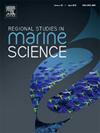影响南黄海增生Ulva藻华的环境因素:来自具有注意机制的深度学习模型的见解
IF 2.4
4区 环境科学与生态学
Q3 ECOLOGY
引用次数: 0
摘要
在这里,我们开发了一个集成了注意力机制的深度学习模型。利用该模型考察了影响黄海南部增殖藻绿潮的环境因素。2022年和2023年的开花盖度在空间分布和时间格局上存在显著差异,2023年开花盖度大幅增加,最大覆盖面积从2022年的261.07 km²扩大到9400.06 km²。水温和盐度等关键环境因子是华花形成的主要预测因子,与华花覆盖呈强正相关。采用了一种新颖的注意卷积神经网络长短期记忆网络模型来预测bloom的发生。该模型的准确率为92.64 %,均方根误差为0.2830,与传统模型相比有了显著提高。值得注意的是,该模型捕获了传统分析中不明显的非线性相互作用,例如2023年风速降低对华花聚集和生长的影响。这些发现证明了将深度学习技术与环境数据相结合以提高预测准确性的有效性。这种方法为了解驱动绿潮的复杂环境相互作用提供了关键的见解。本文章由计算机程序翻译,如有差异,请以英文原文为准。
Environmental factors affecting Ulva prolifera blooms in the South Yellow Sea: Insights from deep learning models with attention mechanisms
Here, we developed a deep learning model with integrated attention mechanisms. We used the model to examine environmental factors influencing Ulva prolifera green tides in the southern Yellow Sea. Analysis of bloom coverage in 2022 and 2023 revealed significant differences in spatial distribution and temporal patterns, with a substantial increase in 2023, when the maximum coverage expanded to 940.06 km² compared to 261.07 km² in 2022. Key environmental factors such as water temperature and salinity were identified as major predictors of bloom formation, showing strong positive correlations with bloom coverage. A novel attention![]() convolutional neural network
convolutional neural network![]() long short-term memory network model was used to predict bloom occurrences. This model achieved an accuracy of 92.64 % with a root mean square error of 0.2830, demonstrating a significant improvement over the conventional model. Notably, the model captured non-linear interactions that were not apparent in traditional analyses, such as the impact of reduced wind speeds on bloom aggregation and growth in 2023. These findings demonstrate the effectiveness of integrating deep learning techniques with environmental data to enhance predictive accuracy. This approach provides critical insights into the complex environmental interactions driving green tides.
long short-term memory network model was used to predict bloom occurrences. This model achieved an accuracy of 92.64 % with a root mean square error of 0.2830, demonstrating a significant improvement over the conventional model. Notably, the model captured non-linear interactions that were not apparent in traditional analyses, such as the impact of reduced wind speeds on bloom aggregation and growth in 2023. These findings demonstrate the effectiveness of integrating deep learning techniques with environmental data to enhance predictive accuracy. This approach provides critical insights into the complex environmental interactions driving green tides.
求助全文
通过发布文献求助,成功后即可免费获取论文全文。
去求助
来源期刊

Regional Studies in Marine Science
Agricultural and Biological Sciences-Ecology, Evolution, Behavior and Systematics
CiteScore
3.90
自引率
4.80%
发文量
336
审稿时长
69 days
期刊介绍:
REGIONAL STUDIES IN MARINE SCIENCE will publish scientifically sound papers on regional aspects of maritime and marine resources in estuaries, coastal zones, continental shelf, the seas and oceans.
 求助内容:
求助内容: 应助结果提醒方式:
应助结果提醒方式:


